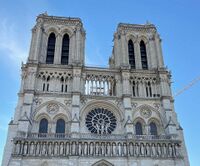Notre-Dame de Paris
Relevance
Mentioned In
Wikipedia Information
 |
Notre-Dame de Paris (French: Cathédrale Notre-Dame de Paris French: [nɔtʁ(ə) dam də paʁi] ; meaning "Cathedral of Our Lady of Paris"), often referred to simply as Notre-Dame, is a medieval Catholic cathedral on the Île de la Cité (an island in the River Seine), in the 4th arrondissement of Paris, France. The cathedral, dedicated to the Virgin Mary ("Our Lady"), is considered one of the finest examples of French Gothic architecture. Several attributes set it apart from the earlier Romanesque style, including its pioneering use of the rib vault and flying buttress, its enormous and colourful rose windows, and the naturalism and abundance of its sculptural decoration. Notre-Dame is also exceptional for its three pipe organs (one historic) and its immense church bells. The construction of the cathedral began in 1163 under Bishop Maurice de Sully and was largely completed by 1260, though it was modified in succeeding centuries. In the 1790s, during the French Revolution, Notre-Dame suffered extensive desecration; much of its religious imagery was damaged or destroyed. In the 19th century, the cathedral hosted the coronation of Napoleon and the funerals of many of the French Republic's presidents. The 1831 publication of Victor Hugo's novel Notre-Dame de Paris (English title: The Hunchback of Notre-Dame) inspired interest which led to restoration between 1844 and 1864, supervised by Eugène Viollet-le-Duc. On 26 August 1944, the Liberation of Paris from German occupation was celebrated in Notre-Dame with the singing of the Magnificat. Beginning in 1963, the cathedral's façade was cleaned of soot and grime. Another cleaning and restoration project was carried out between 1991 and 2000. A fire in April 2019 caused serious damage, closing the cathedral for repairs; it reopened in December 2024. It is a widely recognised symbol of both the city of Paris and the French nation. In 1805, it was awarded honorary status as a minor basilica. As the cathedral of the archdiocese of Paris, Notre-Dame contains the cathedra or seat of the archbishop of Paris (currently Laurent Ulrich). In the early 21st century, about 12 million people visited Notre-Dame annually, making it the most visited monument in Paris. Over time, the cathedral has gradually been stripped of many decorations and artworks. It still contains Gothic, Baroque, and 19th-century sculptures, 17th- and early 18th-century altarpieces, and some of the most important relics in Christendom, including the crown of thorns, and a sliver and nail from the True Cross.
